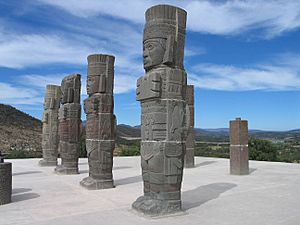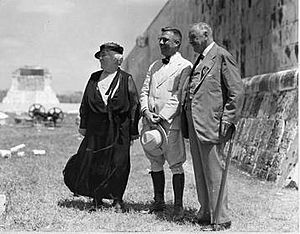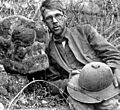Sylvanus Morley facts for kids
Quick facts for kids
Sylvanus Griswold Morley
|
|
|---|---|

|
|
| Born | June 7, 1883 |
| Died | September 2, 1948 (aged 65) |
| Nationality | American |
| Alma mater | • Pennsylvania Military College (1904, civ. eng.) • Harvard (1907 AB; 1908 MA) |
| Known for | •Maya region archaeology and directorship of Carnegie programs • research on Maya calendar and inscriptions • "Old Empire" theory of Classic-era Maya polities • excavations at Chichen Itza • popular writings in archaeology • World War I espionage |
| Scientific career | |
| Fields | Archaeology and epigraphy |
| Institutions | • School of American Archaeology (1907–13) • Carnegie Institution of Washington (1913–40) • School of American Research and Museum of New Mexico (1946–48, director) |
Sylvanus Griswold Morley (June 7, 1883 – September 2, 1948) was an American archaeologist and epigrapher. An epigrapher studies ancient writings. He focused on the pre-Columbian Maya civilization in the early 1900s. Pre-Columbian means before Christopher Columbus arrived in the Americas.
Morley led big digs at the Maya site of Chichen Itza. He worked for the Carnegie Institution. He also wrote many books and articles about Maya hieroglyphic writing. He even wrote popular books about the Maya for everyone to read.
People at the time thought "Vay" Morley was one of the best archaeologists studying Mesoamerica. Mesoamerica is a historical region in North and Central America. Even though some of his ideas have changed, his writings, especially about the Maya calendar, are still used today. As a director for the Carnegie Institution, he helped many other archaeologists start their careers. His passion for Maya studies helped get money for projects. These projects taught us a lot about the ancient Maya.
Contents
Becoming an Archaeologist
Early Life and Education
Sylvanus Morley was born in Chester, Pennsylvania. He was the oldest of six children. His father taught at the Pennsylvania Military College (PMC). His mother's father also taught there.
When Morley was ten, his family moved to Colorado. He finished high school in Buena Vista and Colorado Springs. In Colorado, he became interested in archaeology. He first wanted to study ancient Egypt.
His father, an engineer, wanted Sylvanus to study engineering. He thought archaeology would not lead to a job. So, Sylvanus studied civil engineering at PMC. He graduated in 1904.
Studying the Maya at Harvard
Right after PMC, Sylvanus went to Harvard University. He wanted to study archaeology. At Harvard, his focus changed from Egypt to the Maya. This was thanks to his professors, F. W. Putnam and Alfred Tozzer. Morley might have been interested in the Maya even earlier. He loved the book Heart of the World by H. Rider Haggard. This book was about "lost cities" in Central America.
Morley earned his degree from Harvard in 1907. His first trip to Mexico and Yucatán was in January 1907. He visited many Maya sites like Acanceh and Chichen Itza. At Chichen Itza, he helped with digging in the Sacred Cenote. A cenote is a natural sinkhole filled with water. He brought artifacts from the cenote back to Harvard's Peabody Museum.
In the summer of 1907, Morley worked for the School of American Archaeology (SAA). He did fieldwork in the American Southwest. He studied sites of the ancient Pueblo peoples. Morley helped define a special "Santa Fe" style of ancient architecture.
After this, Morley worked full-time for the SAA. He worked in both the Southwest and in Mexico and Central America. He finished his Master of Arts degree at Harvard in 1908.
Working with the Carnegie Institution
Planning the Chichen Itza Project
In 1912, the Carnegie Institution decided to fund an anthropology department. They asked for ideas for projects. Morley suggested exploring and digging at Chichen Itza.
The Institution approved Morley's plan in December 1913. They hired him to lead the project. But problems in Yucatán and World War I delayed the work. The digging at Chichen Itza did not start until 1923.
While waiting, Morley went on other trips for the Carnegie Institution. He also published his first big book, An Introduction to the Study of Maya Hieroglyphs (1915).
Fieldwork Across the Maya Region
Morley spent almost 20 years doing fieldwork in the Maya region. He managed seasonal digs and restoration projects. He would return to the U.S. in the off-season to give talks. While he focused on Chichen Itza, he also helped with other Maya sites. These included Yaxchilan, Coba, Copán, Quiriguá, and Uxmal.
Morley rediscovered the site of Uaxactun in Guatemala. He believed there were many unknown ancient Maya sites. He offered a reward to local chicleros (people who collected natural gum). They traveled through the jungles and helped him find new sites. Morley even named Uaxactun. The name comes from a stela (stone monument) he found there. It recorded a Maya Long Count Calendar date.
Morley earned the trust of the local Yucatec Maya around Mérida. He often acted as their representative. He was careful not to upset the Mexican or U.S. governments.
Over time, managing many projects became difficult for Morley. The Carnegie board felt he was not good at overseeing everything. In 1929, Alfred V. Kidder took over as overall director. Morley then focused only on Chichen Itza.
Morley's health suffered from working in the Central American jungles. He often got malaria and other illnesses. He also developed heart problems. But he kept working with great excitement, even though he disliked the jungle.
Morley wrote several books about Maya hieroglyphics. These included a study of writings at Copán (1920). He also wrote a huge five-volume study of sites in the Petén Basin (1932–38).
Excavating Chichen Itza
About Chichen Itza
Chichen Itza is about 75 miles (120 km) southeast of Mérida. Europeans first learned about it in the 1500s. The Spanish tried to make it their capital during the Spanish conquest of Yucatán. But the Maya drove them out.
Chichen Itza was mostly abandoned before the Spanish arrived. But local Maya still lived nearby. They saw the site as a special place for ceremonies. The name "Chichen Itza" means "mouth of the well of the Itza". The "well" is the nearby Sacred Cenote.
Starting the Carnegie Project
By 1922, the political situation in Mexico was more stable. This allowed the Carnegie Institution's Chichen Itza project to begin. Morley and Carnegie President Charles Merriam visited Chichen Itza in 1923. The Mexican government was already restoring the pyramid, El Castillo. Morley showed Merriam the best area for their dig. This was a group of mounds called the Group of One Thousand Columns.
When Morley and his team returned in 1924, Chichen Itza was mostly hidden. Many buildings were covered by earth and plants. Some parts had been studied before, but not much digging had happened. The Carnegie project would be much bigger.
Discoveries at Chichen Itza
In 1924, Morley and his team began their first digs. They chose an area in the site's main plaza. They found many rows of free-standing columns. This was surprising because columns were not common in Classic Maya architecture. This area, now called the "Complex of a Thousand Columns," was unusual. It looked more like buildings from central Mexico, over a thousand kilometers away. It was similar to structures at Tula, the capital of the Toltecs.
Over the next few years, the team found other unique buildings. These included the Temple of the Jaguar and the Temple of the Warriors. In 1927, they found an older structure under the Temple of the Warriors. They called it the "Temple of the Chacmool" after a statue found there. These buildings had paintings that mixed Maya and non-Maya styles. They also worked on restoring el Caracol, a round building that was an observatory. The Mexican government also had a dig at the site. The two teams worked side-by-side.
While others managed the daily work, Morley copied inscriptions. He especially focused on dates. Most dates at Chichen Itza were in a short form. This made it hard to know exactly when events happened.
In later years, the project focused on finishing the restoration. Morley wanted to research the site and rebuild it for tourism.
What We Learned from Chichen Itza

The digs at Chichen Itza showed a mix of building styles. There were different Maya styles and many Mexican influences, especially Toltec. Evidence suggested the site had been lived in since the mid-Classic period. It became a major power in the Post-Classic period.
Many believed that Toltec warriors from the west invaded Chichen Itza in the 900s. They thought the Toltec ruled the local Maya for about a century. Morley generally did not believe in outside groups influencing the Maya. But he accepted this idea because it happened in the "later" Post-Classic period.
Today, many experts question this idea of an invasion. They think the similar styles came from cultural diffusion and trade. This means ideas and goods spread between cultures.
The Carnegie digs added a lot of information about Chichen Itza. The site's restoration by Carnegie has lasted. Today, Chichen Itza is one of the most visited ancient ruins in Central America and Mexico. Over a million people visit each year.
Later Years and Legacy
Project End and Final Work
After almost 20 years, the Carnegie's Chichen Itza project ended in 1940. Morley and his second wife, Frances, moved to Mérida.
Morley then spent more time in Santa Fe, New Mexico. He had lived there half the year since 1910. In 1940, he joined the American Philosophical Society. He became director of the School of American Research and the Museum of New Mexico in 1946. He also wrote a big book for everyone about ancient Maya society. This book, The Ancient Maya, was published in 1946. It was very successful and has been updated and reprinted many times.
Morley last visited Yucatán in 1948, just months before he died. He died in Santa Fe on September 2, 1948, at age 65. He was buried in Santa Fe's Fairview Cemetery.
Morley's personal library is kept at the Laboratory of Anthropology Library in Santa Fe.
Morley's Ideas and Impact
In his time, Morley was seen as a top Maya scholar. He and Eric Thompson believed the ancient Maya were peaceful astronomers. They thought the Maya were obsessed with time and calendars. This idea was popular for decades. However, new discoveries in reading Maya hieroglyphic writing have changed this view. We now know the Maya were also concerned with rulers, wars, and history.
Morley's research is still important, but some of his ideas have been updated. He helped many scholars get their start, like J. Eric S. Thompson and Tatiana Proskouriakoff. Thompson became a leading expert. Proskouriakoff's research later showed that some of Morley's and Thompson's ideas were not quite right.
Morley was very interested in the Maya calendar. He helped explain how it worked. He was good at finding calendar dates on old inscriptions. But sometimes, he focused so much on dates that he missed other details in the writings.
As a director of digs, Morley was well-liked. The restored sites like Chichen Itza were admired. But some later researchers felt that the research from these projects could have been more detailed.
Despite later changes to his theories, Sylvanus Morley is still an important figure in Maya studies. His books are mostly replaced by newer research, except for his calendar studies. His work on ancient writings is also mostly outdated. But his biggest contributions were starting the Carnegie research programs. He also inspired and supported other scholars. His restoration work made Maya sites famous. He was great at sharing his excitement about the Maya with everyone. He was seen as the classic explorer of Central America, often wearing his pith helmet. Some people even think he might have inspired the character of Indiana Jones!
Morley also spoke up for the Maya peoples. He spent a lot of time with them. He helped them share their concerns with the wider world.
Major Books
Morley's important books include:
- 1915 – An Introduction to the Study of Maya Hieroglyphs
- 1920 – The Inscriptions of Copán
- 1938 – The Inscriptions of Petén (5 volumes)
- 1946 – The Ancient Maya (This book has been updated and reprinted many times.)
Morley also wrote popular articles about the Maya for National Geographic Magazine. Many archaeologists say these articles inspired them when they were young.
Morley kept a daily diary about his discoveries and projects. These diaries and his notes are being published online.
The "Other" Sylvanus Griswold Morley
There was another famous person named Sylvanus Griswold Morley. This was Sylvanus the archaeologist's older cousin. He was born in 1878. His original last name was Small, but he changed it to Morley. Because of this, some books mix up details about the two men.
This "other" S. Griswold Morley became a professor of Spanish at the University of California, Berkeley. He is known for his interest in old covered bridges. His book The Covered Bridges of California (1938) is an important book on the topic.
Sylvanus G. (Small) Morley died in 1970.
Images for kids
-
An example of one of Sylvanus Morley's drawings of Maya hieroglyphic inscriptions, taken from his 1915 publication. This illustrates the text appearing on a lintel in the Chichen Itza building commonly known as the "Temple of the Initial Series," as it is the only inscription for the site known to show a Maya Long Count Calendar date. The date shown here (starting row 2, ending at A5) is 10.2.9.1.9 9 Muluk 7 Sak (equivalent to July 30, 878 CE).
See also
 In Spanish: Sylvanus Morley para niños
In Spanish: Sylvanus Morley para niños







